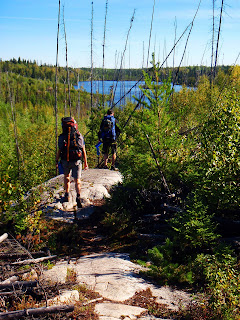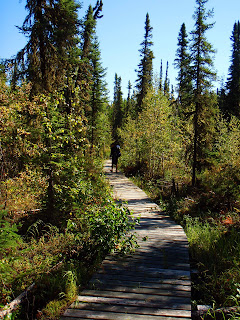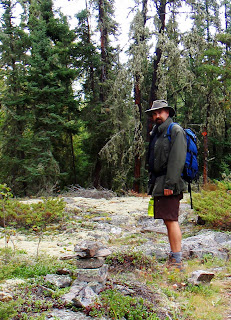Sidney Castel, the Cree pop music phenomenon, lived in the remote northern settlement of Pukatawagan, Manitoba. He was most famous for his Pukatawagan Song and the Thompson Song. He had just finished recording a new CD, Live at the Beaver Lodge, released by Sunshine Records, when he passed away at age 68. (worldwidesunshine)
I ended my 2008 trip in Pukatawagan and found the people to be very friendly and helpful. There are no roads to Puk, the only way in or out is by plane, boat or train. I chose to take the train back to the south but didn't know where to purchase a ticket. When I asked a local where the post office was, thinking that a ticket could be purchased there, the fellow responded "what post office, there is none, this is the north." In speaking with another local I was advised to just toss my stuff on an open rail car and hitch a ride when the train came in a couple of days. As it turned out I caught a ride with a fellow that worked for the rail company. He was driving a high rail (suburban with train wheels) back and forth on the track.
Tuesday, September 28, 2010
Saturday, September 25, 2010
Super sized cord lock
I've added the following to the Pulk v4.0 post but here it is again.
I think I'm going to use a shock cord lashing system to secure the load into my pulk. It took nearly 35 feet of shock cord to "lace up" my pulk and the way I secured the ends was to use a super sized cord lock. Now the cord locks that are available for purchase are way too small! The 3/32" shock cord would never fit so I decided to make my own. I cut a one inch piece of pvc pipe to 4 inches. I then sanded down a wooden dowel to just fit in side the pipe. A 3/8 inch hole was drilled in through both. A very stiff 2" spring was sent down the pipe from the end that didn't have the dowel sticking out. To cap off the end I used a 1/2inch piece of pvc pipe. It just happens to fit very snug inside the 1 inch pipe. This plug was driven in with a mallet until the desired tension was reached. Now I am able to pull the shock cord tight and secure it with the cord lock.
I think I'm going to use a shock cord lashing system to secure the load into my pulk. It took nearly 35 feet of shock cord to "lace up" my pulk and the way I secured the ends was to use a super sized cord lock. Now the cord locks that are available for purchase are way too small! The 3/32" shock cord would never fit so I decided to make my own. I cut a one inch piece of pvc pipe to 4 inches. I then sanded down a wooden dowel to just fit in side the pipe. A 3/8 inch hole was drilled in through both. A very stiff 2" spring was sent down the pipe from the end that didn't have the dowel sticking out. To cap off the end I used a 1/2inch piece of pvc pipe. It just happens to fit very snug inside the 1 inch pipe. This plug was driven in with a mallet until the desired tension was reached. Now I am able to pull the shock cord tight and secure it with the cord lock.
Monday, September 13, 2010
Nut Point Hiking Trip
 On the Labour Day long weekend Zoe, myself and our friend Shaun hiked the Nut Point Trail which is located just on the north edge of La Ronge SK. The trail head is located in a parking lot at the Nut Point Provincial camp ground.
On the Labour Day long weekend Zoe, myself and our friend Shaun hiked the Nut Point Trail which is located just on the north edge of La Ronge SK. The trail head is located in a parking lot at the Nut Point Provincial camp ground. Along the trail we hiked through mixed forests of deciduous and coniferous trees, over high granite outcroppings and descended into dark, damp bogs. Many of which have a boardwalk over the wettest areas. The trail also passes through the Mallard fire that burnt in 1999.
Along the trail we hiked through mixed forests of deciduous and coniferous trees, over high granite outcroppings and descended into dark, damp bogs. Many of which have a boardwalk over the wettest areas. The trail also passes through the Mallard fire that burnt in 1999. Much of the trail follows exposed bedrock. This section was comprised of some interesting metamorphic rock.
Much of the trail follows exposed bedrock. This section was comprised of some interesting metamorphic rock. Being a point that has development on both sides doesn't lend itself to viewing wildlife but we did flush this Spruce grouse out of the under brush.
Being a point that has development on both sides doesn't lend itself to viewing wildlife but we did flush this Spruce grouse out of the under brush. The weather on the first day was very nice though windy. Luckily our campsite was on the lee side of the point.
The weather on the first day was very nice though windy. Luckily our campsite was on the lee side of the point. The view from the Nut portage was impressive as well as the small but comfortable camp site that is located there.
The view from the Nut portage was impressive as well as the small but comfortable camp site that is located there. On the first day our plan was to hike part way and set up camp. We ended up stopping at the Nut Portage and as it turns out it is one of the best spots on the trail to camp. Second only to the point itself. Then the second day we did a day hike to the point and back to our camp where we stayed another night. On the third day we packed up and hiked out. This spot isn't used much by campers so fire wood was in abundance.
On the first day our plan was to hike part way and set up camp. We ended up stopping at the Nut Portage and as it turns out it is one of the best spots on the trail to camp. Second only to the point itself. Then the second day we did a day hike to the point and back to our camp where we stayed another night. On the third day we packed up and hiked out. This spot isn't used much by campers so fire wood was in abundance. The saying goes "Pink sky at night is a sailors delight, Pink sky in the morning is a sailors warning". I guess sailors doesn't always know what they are talking about, though we enjoyed a great sunset and magnificent starts that night. The weather wouldn't hold.
The saying goes "Pink sky at night is a sailors delight, Pink sky in the morning is a sailors warning". I guess sailors doesn't always know what they are talking about, though we enjoyed a great sunset and magnificent starts that night. The weather wouldn't hold. The wind on the second day continued to blow and the clouds gave up their contents for most of the day as we hiked to the point and back as a day hike.
The wind on the second day continued to blow and the clouds gave up their contents for most of the day as we hiked to the point and back as a day hike.The view from the point the day that we arrived.
 Despite the rain, wind and cool temperatures our spirits were high as we walked along the trail back to camp.
Despite the rain, wind and cool temperatures our spirits were high as we walked along the trail back to camp. I asked Shaun if we should still go even if the forecast was calling for rain. He said that he likes the rain.
I asked Shaun if we should still go even if the forecast was calling for rain. He said that he likes the rain. We were lucky enough to have cut and stashed a small amount of fire wood under the tarp before it began to rain. Upon arriving back at camp we moved the fire under the tarp and began to dry out. We only had a small amount of wood so we were only able to have a small fire but we managed to keep warm and enjoyed our second evening around the fire drinking two of the three litres of wine we packed in as well as smores.
We were lucky enough to have cut and stashed a small amount of fire wood under the tarp before it began to rain. Upon arriving back at camp we moved the fire under the tarp and began to dry out. We only had a small amount of wood so we were only able to have a small fire but we managed to keep warm and enjoyed our second evening around the fire drinking two of the three litres of wine we packed in as well as smores.Thursday, September 9, 2010
Where's the snow???
I know it's only the begining of September, and as far as I'm concerned summer lasts until November but I just finished building a pair of traditional snowshoes and I'm dying to try them out. My first pair of snowshoes were the new style with aluminum frames and Olefin decking. I like them but the problem is they are very loud. The deck material produces a defening crunch on the snow reducing any chance of seeing wildlife. A number of people that I snowshoe with use the traditional wooden / rawhide style of which are much quieter which is why I've decided to go that route. Another reason I chose to use wood as the material of choice is that I'm trying to, somewhat, revert back to more traditional materials. I'm trying to come up with a blend of new and old, low tech and high tech. Some of the materials of old perform just as well as the new space aged materials so I see no reason to use them.
Using Gilpatricks book Building Snowshoes as a reference, I chose the Ojibway design mainly for its simplicity in the construction. Unlike many Ojibway snowshoes which are symmetrical I've decided to make mine asymmetric with the widest point forward of center. They measure 62" X 12". The filling for the main body is 3/8" nylon webbing. For the toe and heal sections I used 1/8" nylon cord. Three coats of Spar Varnish was applied to seal the wood and filling. As for the bindings, I'm not sure what I'm going to do. For now I'm thinking about just using lamp wick but am concerned that it will not hold my foot secure. I am seriously considering the MM 103-U binding from American Mountain Man. Or may make my own.
Using Gilpatricks book Building Snowshoes as a reference, I chose the Ojibway design mainly for its simplicity in the construction. Unlike many Ojibway snowshoes which are symmetrical I've decided to make mine asymmetric with the widest point forward of center. They measure 62" X 12". The filling for the main body is 3/8" nylon webbing. For the toe and heal sections I used 1/8" nylon cord. Three coats of Spar Varnish was applied to seal the wood and filling. As for the bindings, I'm not sure what I'm going to do. For now I'm thinking about just using lamp wick but am concerned that it will not hold my foot secure. I am seriously considering the MM 103-U binding from American Mountain Man. Or may make my own.
Subscribe to:
Posts (Atom)












